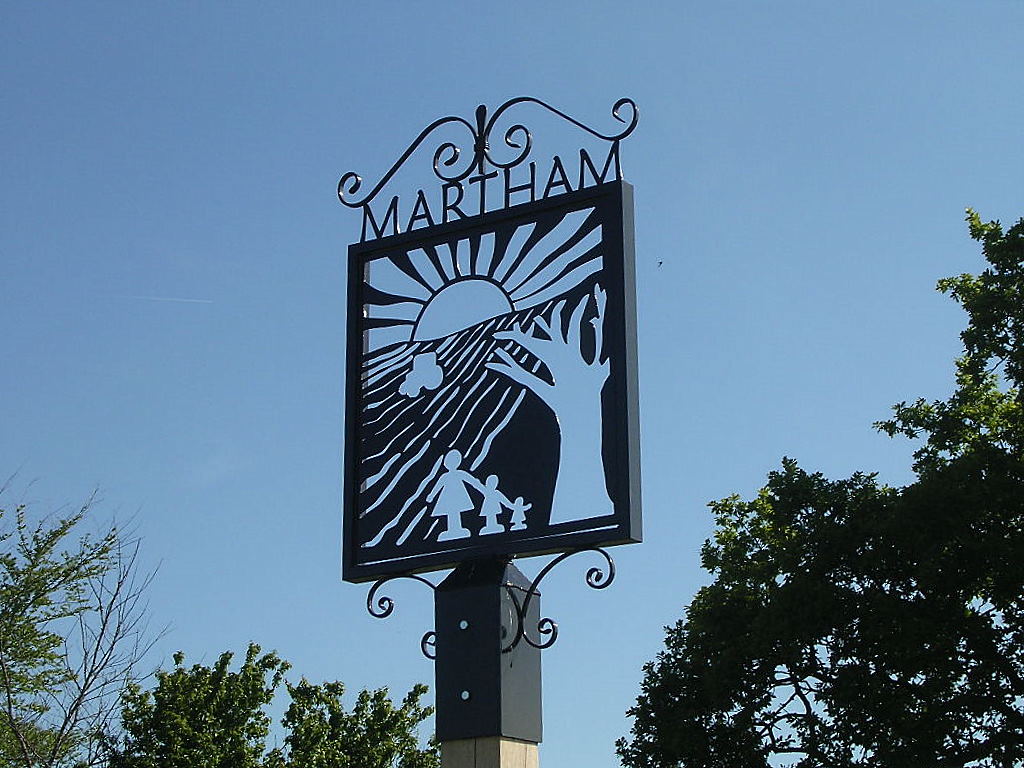
Ornamental Sign
The Parish Magazine of August 1973 first published the idea of the village having what was then called an ornamental sign. The idea quickly gained in popularity and in November of the same year a letter from Mr F W May of Pine Close requesting a sign was first discussed by the Parish Council. Even at that early stage a design was suggested by Councillor George Cooke and in May 1974 it was also decided to request a design from the Art Teacher at the Secondary Modern School and her pupils. It must have been a popular topic because in July 1974 a Mr Bernard Bould put forward another design which the Parish Council deferred whilst waiting to hear from the Art Mistress.
It was not until 26th November 1974 that a design from Mr T W Fanthorpe was accepted. He had prepared this based on ideas from a field study his sister, Miss J Fanthorpe, had researched as part of a college course but the final version incorporated features suggested by various local residents. A quote of £125.00 to make the sign was accepted from Mr Harry R Carter of Swaffham. Harry Carter was a nephew of the renowned Egyptologist Howard Carter. A Londoner, he trained at the Slade College of Art and became the arts and crafts master at Hammonds Grammar School in Swaffham. By the time of his death in 1983 he had carved over 200 town and village signs.
The magnificent 15th century church of St Mary the Virgin provides a background on one side of the sign showing a gallant knight defending the honour of a fair maiden from a marauding Viking raider who has probably arrived in the galley ship shown just behind. The Vikings played a large part in the history of the surrounding area. The other side displays a more modern theme of a wherry, a trading ship of the Broads at the turn of the 19th century, which was no doubt a nodding reference to the three staithes associated with the village. There is a wind pump behind the wherry and Martham has two wind pumps which were used to drain the marshes to allow livestock to graze.
At the end of September 1975, the sign had been completed and arrangements were set in motion for it to be erected on The Green at a grand opening ceremony. At 2.15pm on 26th October 1975 Borough Councillor and former Mayor, Councillor W D Davey performed the unveiling attended by representatives from all the religious denominations in the village. Mr Alfred Harris was thanked for erecting the sign on a concrete and flint base which he had done free of charge.

In July 1977 the sign was touched up by Mr D Finch of Willow Way and he again carried out repairs costing £17.50 in June 1980. The double sided sign is carved out of wood and being open to all weathers had suffered the ravages of time by 2010 when it was removed from its post and given a thorough and complete overhaul and re-painting by the then Chairman of the Council Mike Huke on a voluntary basis.
By March 2015 the weather had again taken its toll and the painted wood was in need of major restoration so this time the sign was repaired and repainted by north Norfolk-based artist Fiona Davies, who has worked on dozens of village markers around Norfolk and Suffolk. “I’m not a trained wood carver, but I love working with wood and heritage is important to me so it’s really a privilege,” said Miss Davies, who continued: “We take the paint off by hand, we don’t use paint stripper because that can start wood rot. Everything’s done by hand so it can be quite a painstaking process. After it’s been painted resin is used to make it watertight.”
Thus, it remains an often-photographed centre of attention at a key junction and focal point of the village. Is curious how the sign seems to have changed the way it faces since 1975.
Welcome Village Signs
Martham has four welcoming signs that denote entry into the village on Rollesby Road, Somerton Road, Repps Road and Hemsby Road.
First conceived in 2004 the specification for the designs was that they “should be simple yet unique to reflect local history, industry and the environment. Preferably created by a local artist taking into account the intended material and method of manufacture.”
The Carnival Committee donated £800 towards the cost of the signs in May 2004 and members of the Carnival Crew were included on a judging panel to assess suggestions. A specification pack was compiled by the Parish Council and a competition launched for design suggestions. The response was enormous and by December 2004 approximately 1,000 suggestions had been made most of them by local residents and school children. Not surprisingly it took the judging panel several months to sort through the suggestions and in March 2005 they announced that there was no clear winner but the best parts of many suggestions had been put together for each sign to be different and reflect the variety of village life.
It took another year for the sitings to be agreed, the artwork to be completed and quotes obtained. The signs was ordered from Signs of The Times from Bedfordshire who are specialists in the supply of bespoke cast house signs, street furniture, street signs, commemorative plaques and coats of arms etc. All four signs were erected in March 2007.




Photographs
Click a thumbnail for a close-up and scroll through all the images from there.



